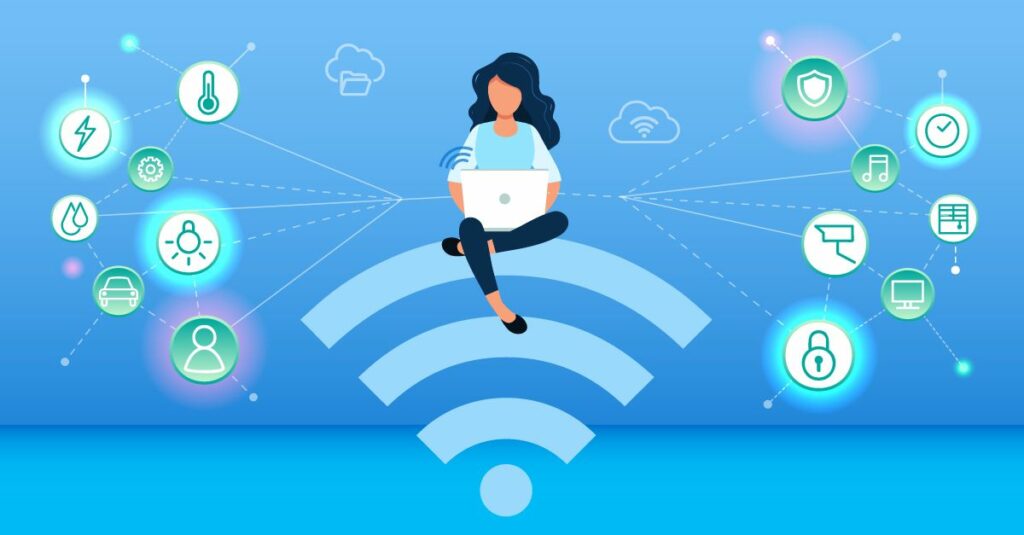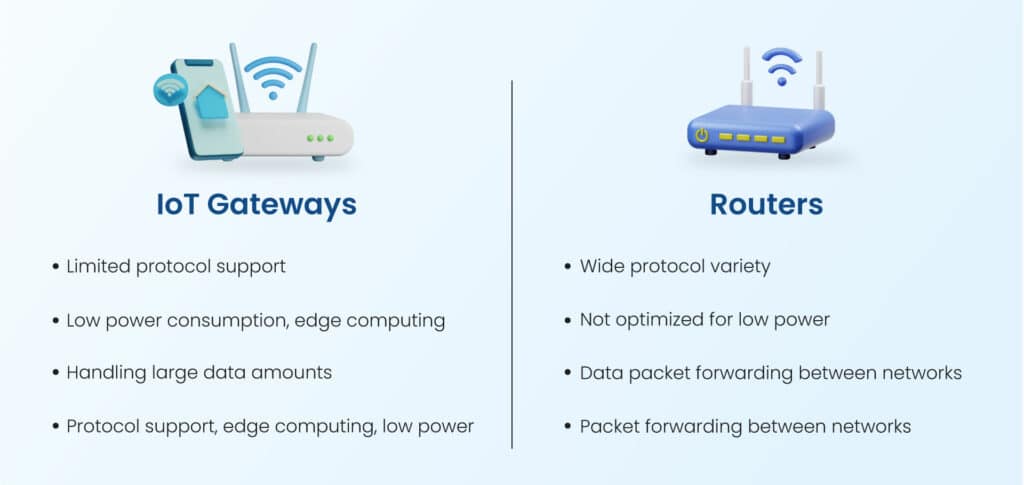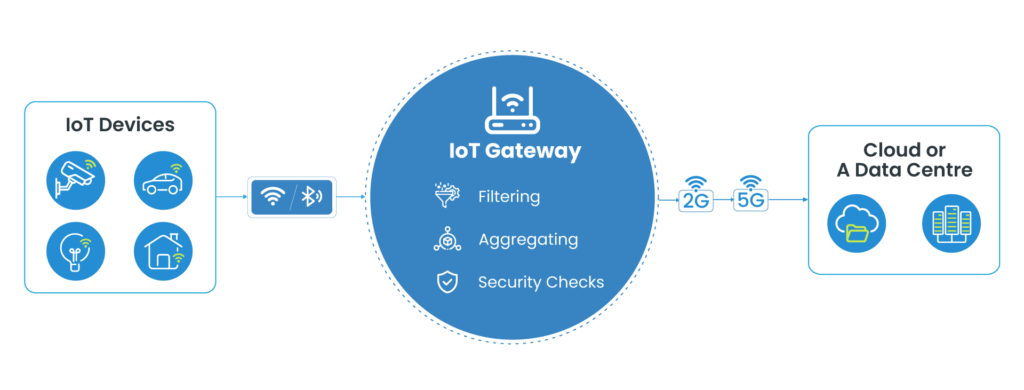What is IoT Gateway? How to Develop IoT Gateway
An IoT (Internet of Things) gateway is a device or software that connects local IoT devices with the Internet. Additionally, it facilitates communication and data transfer between IoT devices and cloud-based applications or services.
Functioning as a mediator, the gateway acquires data from connected devices and securely transmits it to the cloud or other network destinations. This is accomplished by conducting data filtering, protocol translation, and security operations, guaranteeing uninterrupted connectivity and safeguarding confidential information.
Through the consolidation and management of IoT device connectivity, an IoT gateway allows for centralized control, data analysis, and remote monitoring of connected devices and their data.

What is the difference between an IoT Gateway and a Router?
The Internet of Things (IoT) has permeated numerous industries and, with it, the requirement for device connectivity. Two technologies that are frequently utilized to enable this connectivity are IoT gateways and routers. They are different in certain aspects, even though they have some similarities.
Differences between IoT Gateway and Router
Here are some key differences between an IoT gateway and a router:

- Routers usually accept only a few communication protocols, but IoT gateways support a wide variety.
- IoT gateways optimize for low power consumption, while routers are not. IoT gateways can perform edge computing, although routers are not intended to handle this task.
- While routers are primarily made to forward data packets between networks, IoT gateways are made to handle large amounts of data.
- Two technologies that assist device connectivity are IoT gateways and routers. Although they have some similarities, they also have some significant differences.
- While routers primarily forward data packets between networks, IoT gateways support various protocols, perform edge computing, and optimize for low power consumption.
How does an IoT Gateway work?
An IoT gateway is a hardware or software device that bridges IoT devices, the cloud, or a data center. It serves as a central point of control for the devices and enables communication between them and the cloud or data center. Here’s how a gateway typically works:

Data Collection
IoT devices such as sensors, cameras, and other intelligent devices collect and transmit data to the gateway. The gateway collects this data using a variety of communication protocols, including Wi-Fi, Bluetooth, Zigbee, and Z-Wave.
Protocol Translation
IoT devices may use different communication protocols, and the gateway must translate these protocols into a common language to communicate with each other. The gateway translates the data into a standard format that can be understood by the cloud or data center.
Data Processing
The first step to developing an IoT gateway is to define the requirements. This involves determining the types of devices the gateway will support, the communication protocols it will use, and the functionality it will provide. Defining these requirements will guide the development process and ensure that the gateway meets the needs of the intended users.
Device Management
They manage the devices connected to them, ensuring they work correctly and communicate with the cloud or data center. The gateway performs firmware updates, security checks, and other device maintenance tasks.
Edge Computing
One of the key features of IoT platforms is their ability to perform edge computing. Edge computing involves processing and analyzing data at the network’s edge, close to where the data is generated. This allows faster processing times, lower latency, and reduced bandwidth requirements. It can perform edge computing by running applications and analytics locally on the device rather than sending all data to the cloud or data center.
Cloud Connectivity
Gateways are designed to connect with the cloud or data center, allowing data to be stored and analyzed. The gateway sends the data to the cloud or data center for further analysis, storage, and retrieval. The cloud or data center can then provide real-time feedback to the devices or send commands back to the gateway to control the devices.
The gateway acts as a bridge between IoT devices and the cloud or data center. Furthermore, it collects data from the devices, translates the communication protocols, and processes it. In addition, the gateway manages the devices, performs edge computing, and connects with the cloud or data center to store and analyze the data. It is important to note that a gateway is a critical component of any IoT solution. Consequently, it provides the necessary connectivity and intelligence to seamlessly make IoT devices work together.
IoT Architecture Overview
An IoT system typically consists of three layers: the device layer, the gateway layer, and the cloud layer. Each layer has a specific function and works together to provide a complete IoT solution.
Device Layer
The device layer consists of the physical devices that collect data and interact with the environment. These devices include sensors, cameras, smart appliances, and other IoT devices. They are responsible for collecting data and transmitting it to the gateway layer.
Gateway Layer
The gateway layer is the middle layer of the IoT architecture, bridging the device and cloud layers. It performs various functions like protocol translation, data aggregation, and edge computing. Additionally, it ensures security, manages devices, and establishes connectivity to the cloud.
Communication Layer
The Communication Layer facilitates data transmission between the devices and the gateway, ensuring reliable and efficient communication.
Cloud Layer
The cloud layer is the top layer of the IoT architecture. It provides storage, processing, and analytics capabilities for the data collected by the devices. The cloud layer can also provide real-time feedback and send commands to the gateway layer to control the devices.
IoT Architecture Diagram
Here’s a diagram that illustrates the typical architecture of an IoT system:

In this diagram, the devices in the device layer collect data and transmit it to the gateway layer. The gateway layer processes the data and sends it to the cloud for storage and analysis via the communication layer. The cloud layer provides real-time feedback to the devices and sends commands to the gateway layer to control the devices. The gateway layer also provides security and connectivity to the cloud layer.
IoT architecture enables communication and interaction between devices, the gateway, and the cloud. It provides the necessary infrastructure to collect, process, analyze and control IoT device data remotely.
How to Develop an IoT Gateway
Let’s see the steps for how to develop the IoT Gateway.

1. Define the Requirements
The first step to developing an IoT gateway is to define the requirements. This involves determining the types of devices the gateway will support, the communication protocols it will use, and the functionality it will provide. Defining these requirements will guide the development process and ensure that the gateway meets the needs of the intended users.
2. Choose the Hardware and Software
Once you define the requirements, you must choose the hardware and software for the gateway. This entails selecting the processor, memory, storage components, operating system, and other software components. You must choose the hardware and software based on the requirements and the expected workload of the gateway.
3. Design the Gateway Architecture
Designing the gateway architecture is the third step. This task involves deciding on the components and interfaces used and the data flow and processing logic. The design should meet the requirements and ensure scalability and flexibility to accommodate future changes.
4. Implement the Gateway
The next step is implementing the gateway, which involves writing the code and assembling the hardware. This includes developing the drivers and interfaces for the devices and implementing the communication protocols and data processing logic. The gateway should be thoroughly tested to ensure it meets the requirements and is reliable and secure.
5. Deploy and Integrate the Gateway
Once the gateway has been implemented and tested, the next step is to deploy and integrate it into the IoT system. This involves configuring the gateway and connecting it to the devices and the cloud or data center. The gateway should be integrated with the other components of the IoT system to ensure that it works seamlessly with them.
6. Monitor and Maintain the Gateway
The final step is to monitor and maintain the gateway. This involves monitoring the performance and reliability of the gateway and addressing any issues that arise. The gateway should be updated and maintained regularly to remain secure and up-to-date.
Developing a gateway requires defining the requirements, choosing the hardware and software, designing the architecture, implementing the gateway, deploying and integrating it, and monitoring and maintaining it. Following these steps can help ensure that the gateway meets the users’ needs and functions reliably and securely within the IoT system.
Conclusion
An IoT gateway is a crucial component of an IoT system, ensuring its security and reliability. Moreover, Thinkitive Technology offers custom IoT development with architecture, hardware, software, and cloud integration expertise. By partnering with us, you can ensure high quality, reliability, and security standards for your IoT system. Additionally, we tailor the gateway architecture to your needs, integrate it with existing systems, and provide ongoing maintenance for optimal performance. Therefore, choosing Thinkitive Technology as your IoT development partner guarantees functional and secure gateways.
Embrace the future of technology with our team of IoT developers available for hire. Elevate your projects to new levels by leveraging the expertise of our skilled IoT developers through our flexible trial period. Hire IoT developers today.




